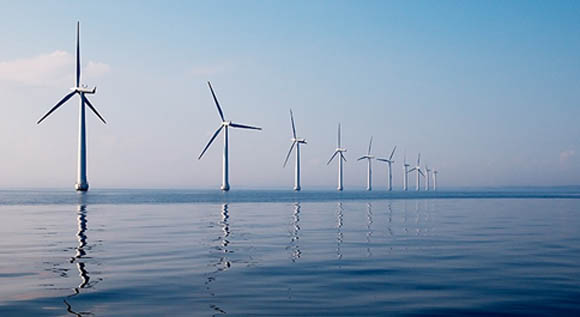Alliance for a cross-border energy transition at sea
Germany chaired the North Seas Energy Cooperation for a year. In this group, nine countries and the European Commission work together to develop offshore wind energy and the grid infrastructure at sea. Here's an initial review.
 © iStock.com/Dieter Beselt
© iStock.com/Dieter Beselt
What a gigantic task Europe has taken on: our continent is to become climate-neutral by 2050. An important key to achieving this can be found far out at sea. In the offshore sector alone, according to data from the European Commission, 300 gigawatts of installed capacity (wind power) and investment of €800 billion is needed to achieve this ambitious goal. This could help offshore wind to become one of the most important sources of renewable energy with a view to climate neutrality and a driving force for the recovery of the European economy following the COVID-19 pandemic. However, this will be difficult to achieve without cross-border European cooperation, as the potential European contribution of offshore wind energy by 2050 is more than ten times today’s installed capacity of 23 GW. Annual installation rates of currently 3 gigawatts per year will have to scale up considerably in the coming years.
Nine countries, one goal: more offshore wind energy in the North Sea
It is already the case that more and more wind power generated offshore is reaching the shores of the North Sea. Nine European countries wishing to use it, and the European Commission, are therefore working together in the North Seas Energy Cooperation (NSEC) to develop offshore wind energy and the grid infrastructure at sea. Over the last twelve months, Germany chaired this energy cooperation forum. The focus is on the expansion of offshore wind energy and offshore grid infrastructure in the region. A particularly important role is played by joint and 'hybrid' projects (offshore wind projects in which the powerlines are interconnected or are connected to the coastlines of several Member States). They thus embrace the generation, transport and cross-border trade of electricity. Hybrid projects can make cost-efficient use of more remote areas and areas located in border regions of the Exclusive Economic Zones for the expansion of offshore wind power. For example, existing wind farms from several countries are to be linked up so that a powerline is created between two or more countries – as happened recently between Denmark and Germany. This joint grid can be used to bring offshore wind power on shore, and also for cross-border electricity trading (as reported).
At the online ministerial meeting between the energy ministers of the North Seas countries and Kadri Simson, the EU Commissioner for energy policy, Germany made a positive initial assessment of its period as chair, and handed the baton on to Belgium. The meeting focused mainly on the implementation of the EU’s Offshore Renewable Energy Strategy and Commission initiatives envisaged for 2021.
A special focus under the German chair was placed on the advancement of joint and hybrid offshore wind projects like that between Denmark and Germany, and an appropriate European policy framework to improve cooperation on the use of offshore wind energy. Here, Germany and its partners succeeded in making key substantive progress and drawing attention to these issues.
EU Offshore Strategy takes up many issues from the NSEC declaration
In a joint declaration in July 2020, the North Seas countries called on the European Commission to present an EU Enabling Framework for joint and hybrid projects. The framework is to provide EU guidelines for the Member States implementing such cross-border projects, e.g. on an appropriate distribution of costs and benefits, appropriate electricity market rules, and improved and efficient EU funding. The work and ideas from the NSEC fed into the Council conclusions fostering European cooperation in offshore and other renewable energies, which were agreed during the German Presidency of the Council of the EU. The European Commission’s Offshore Strategy, published on 19 November 2020, also takes up many elements which were already contained in the joint declaration by the North Seas Energy Ministers, and particularly proposals on how an EU Enabling Framework for cross-border offshore renewable energy projects can tackle impediments to cross-border offshore renewable projects. The Commission’s strategy forms the basis for further discussions and specific guidelines, measures and legislative initiatives to be proposed in the coming years and discussed and negotiated with the Member States.
Belgium taking over NSEC chair in 2021
Belgium, which is taking over the chair of the NSEC in 2021, intends to continue work on the dossier. A further three-year extension to the NSEC cooperation is to be adopted under the Belgian chair. This will involve a renewed exploration of the possibilities for cooperation with the United Kingdom, which plays an important role in terms of offshore wind projects in the North Sea, following its departure from the EU.
The aim is that, soon, the German-Danish example of offshore interconnection will not be the only 'hybrid' interconnector. Other projects in the North and Baltic Sea are already being planned, e.g. the Danish energy hubs (Danish project in the North Sea and Baltic Sea) and the North Sea Wind Power Hub (between the Netherlands, Germany and Denmark).
Further information
- Press release by the Federal Ministry for Economic Affairs and Energy: 'Federal Minister Altmaier chairs video conference of EU energy ministers and hands over chair of North Seas Energy Cooperation to Belgium'
- Article by the Federal Ministry for Economic Affairs and Energy: The North Seas Energy Cooperation
- Article by the Federal Ministry for Economic Affairs and Energy: The winds of change are blowing over the North Sea
- Article by the Federal Ministry for Economic Affairs and Energy: What exactly is the North Seas Energy Cooperation?

